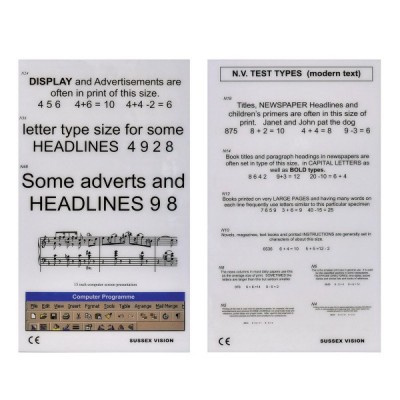Your shopping cart is empty!
Categories
- 50% SALE
- Anatomy of the Eye
- Domiciliary
- Illuminated Cabinets
- Low Vision Aids
- New Products
- Charts & Distance Tests
- COVID
- Clinical Trials Products
- Dispensing & Workshop
- Field Screening
- General Refraction
- Amsler Chart
- Autorefractors & Keratometers
- Bagolini Striated Lenses
- Cardiff Cards
- Clip-on Occluder
- Colour Tests
- Cross Cylinders
- Domiciliary
- Filter Bars
- Fixation Sticks
- Halberg Clips
- Lens Confirmation Tests
- Maddox Phoria Measure
- Maddox Wing Test
- Near Vision
- Occluders
- Optician Starter Kit
- Optokinetic Drum
- Paddle Retinoscopy Rack Set
- Pen Torch
- Polarising Visor
- Prisms & Prism Bars
- Refracto-Rack
- Stereo Tests
- Trial Frames
- Trial Lens Sets
- Trial Lens Spares
- Volk & Ocular Lenses
- Furniture
- Scopes & Loupes
- Sports Vision
Reading Test Type (Modern)
Unique to Sussex Vision
This laminated card is not intended to replace the traditional version (SNT-300-L), rather to compliment it. This Test Type addresses the new requirements and needs of today’s patients. The differences are as follows:
- The type face is modern Arial. This is more in line with type faces used with computers and print in general. The Times New Roman is featured on SNT-300-L.
- The tests start with larger print sizes, progressing down to the smaller text to prevent discouragement of the patient.
- The largest text has been separated and appears on the reverse of the card for low vision patients.
- The musical staff has been reduced to a more realistic size.
- Numerals have been introduced to help with non-English readers and illiterates.
- A section of typical computer presentation has been added at a size consistent with a 15” monitor screen.
- The print size goes down to N4.






